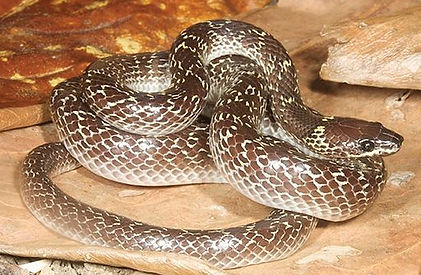Creature
Fast Facts
Introducing you to extinct species.

THE
BULLDOG RAT
1. The bulldog rat, Rattus nativitatis, was one of two rats native to Christmas Island. 2. It was 10.6 inches long and weighed 10.6 ounces. Its tail was an additional 6 inches long. 3. The back of the bulldog rat had a 2 cm layer of fat giving it a distinctive hump. 4. Course reddish-brown hair covering its body. 5. It was extremely sluggish, refusing to climb. It was reported the bulldog rat was “half-dazed in daylight” and was nocturnal. 6. This rat species preferred higher hills and thicker forests on the island. 7. They lived in small colonies under sago palm trees. 8. Black rats brought diseases to Christmas Island, killing off large numbers of bulldog rats. 9. The last reported sighting of a bulldog rat was in 1903.
Extinction
Cometh
Facing the light at the end of the tunnel
EXTINCTION DATE
1903
Christmas Island was named by William Mynors on Christmas Day 1643. The British’s first attempt to make a settlement on Christmas Island in 1857 failed. It wasn’t until 1886 that John Maclear discovered Flying Fish Cove, that a settlement began to take hold. Maclear took scientific notes about the plants and animals on Christmas Island. Unfortunately, it is believed that Maclear inadvertently brought invasive black rats to the island with him. These black rats would have devastating effects on Christmas Island’s two native rat species, the bulldog rat and the Maclear’s rat. Both native rat species were last seen in 1903. It is thought that a combination of factors, diseases, competition, and crossbreeding led to the extinction of the bulldog rat and the Maclear’s rat. The bulldog rat was a slow moving rat, native to Christmas Island. Records of the bulldog rat said that it was unafraid of humans and refused to climb trees. It was perfectly adapted to the tropical environment of Christmas Island, but it lacked the ability to adapt. Its sluggish nature did not help it escape the devastating effects of the black rat invasion. Although Jurassic Park is fiction, scientists are working on several de-extinction projects. In fact, in 2003 scientists did bring back the extinct Pyrenean ibex, a type of wild goat, for 7 minutes before it died, showing de-extinction is possible. The bulldog rat might be a candidate. Scientists would potentially use DNA from museum specimens that might be found. The Australian government has been working on initiatives to protect its native wildlife by restoring lost habitat and eliminating invasive species which have plagued the continent and surrounding island territories. Feral cats, crazy yellow ants, wolf snakes, and giant centipedes are just a few of the non-native species that have led to the extinction of so many animals. Australia has set up a Threatened Species Commissioner and federal environment minister to study these problems and look for solutions to save species currently at risk. Some people are trying to get Christmas Island to be labeled ‘World Heritage Site” to bring more public attention to the problems there. An island biodiversity monitoring program has been set up in Christmas Island as well. If the bulldog rat was brought back to life, could it ever be reintroduced to its native homeland in Christmas Island?
COMING
SOON
The bulldog rat's Lazarus tale has yet to be written, but what adventures will await it when it returns to Christmas Island northwest of Australia? Stay tuned to find out.
More to Explore
All answers lead to more questions
VIDEOS & ADDITIONAL INFO
Extinct Christmas Island Rats Facts
Extinct Christmas Island Rats Research Paper
Fighting Against Invasive Rodents in Australia
List of Extinct Species from Christmas Island
6 Reptiles from Christmas Island
Only Found in Captivity - Video (Christmas Island - 3:53)
Christmas Island Conservation Efforts
Australian Legal Documents of Extinctions & Status of Species on Christmas Island
Christmas Island Pipistrelle Decline - Video

A monograph of a bulldog rat drawn by Charles William Andrews (1866-1924)
Image from Wikipedia

Bulldog rat stamp from 2012
Image from Hip Stamp

Artwork of a bulldog rat by wlgwh.shop
Image from Shop.com

A monograph by Charles William Andrews from 1900 of the bulldog rat and Maclear's rat skulls and teeth Christmas Island
Image from Wikipedia

Map of Christmas Island with its flag
Image from Welt Atlas

Christmas Island location & famous red crabs
Image from US Sun

A Christmas Island postcard showing facts, cultural, history, & native wildlife
Image from Postcards Market

A photo of Gump, the last Christmas Island forest skink, that died on May 31, 2014.
Image from The Conversation

A photo of a Christmas Island forest skink
Image from The Conversation

A stamp showing the critically endangered, possibly extinct Christmas Island shrew
Image from World Wildlife Fund

The Christmas Island Lister's gecko is now extinct in the wild, but being saved by captive breeding
Image from IUCN on X

The Christmas Island blue-tailed skink is now extinct in the wild, but being saved by captive breeding
Image from ABC

The red crab migration is what makes Christmas Island well known
Image from 9 News Australia

The invasive wolf snake had a direct impact on the lizards of Christmas Island
Image from Reptiles of Australia



